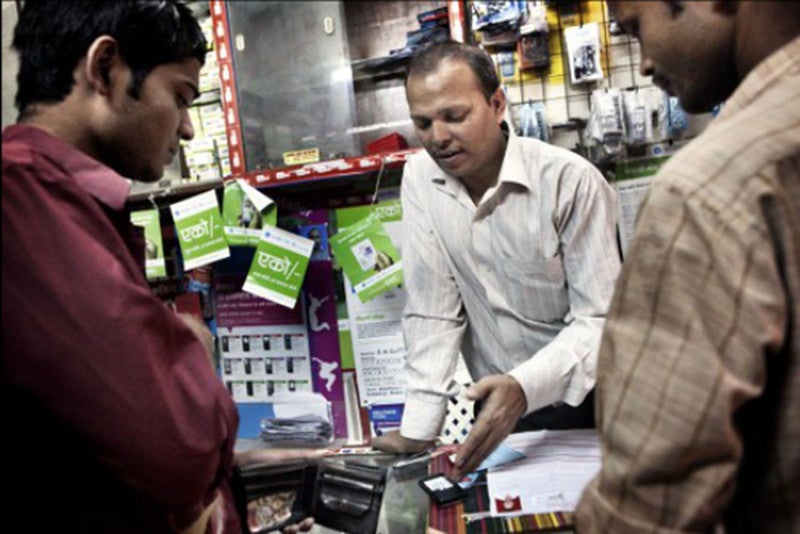Why do Partnerships in Mobile Financial Services Struggle?
Mobile financial services implementations are structurally complex, requiring expertise in banking, telecommunications, technology, marketing and distribution. Typically, they involve some combination of financial institutions, mobile network operators, agent network managers and payment service providers, linked into a seamless service delivery channel. Ultimately, success of these commercial partnerships is crucial to unlocking the great potential that mobile services can have for increasing access to affordable, mass-market financial services in developing markets and elsewhere.
 A shopkeeper shows two men how to use a mobile phone for banking.
A shopkeeper shows two men how to use a mobile phone for banking.
Photo Credit: Marco Gualazzini
So why are so many of these partnerships struggling? After drawing on case studies from Cambodia, Ghana, Kenya and Pakistan, but also from our broader experience in the field, one of our main findings is that only a very limited number of partnerships work well. The quality and impact of these industry partnerships generally depend on the successful definition of partner roles in alignment with competitive advantage and motivation; a long-term view of the division of revenue and cost between the partners; and an accommodating regulatory environment.
Each of the four case studies in our report, Partnerships in Mobile Financial Services: Factors for Success, differs in detail, but there are four high level findings that are applicable across the board and that may provide some guidance to understanding the opportunities and challenges in the evolution of the mobile financial services market.
1. The deficiencies of partnerships typically manifest in some combination of two forms: one or more of the partners is not playing a role that is key to their success, and/or one or more of the partners is playing a role they are ill-equipped or unmotivated to play. For instance, regulations may require banks to assume responsibility for branding an implementation or contract the agent network in a market where the bank has limited ability or commercial interest to do so.
2. The division of revenue and cost between partners plays an important role in the evolution of the implementation, as does the timing of accrual of value to the core business of each partner. Many implementations have taken a short-term view that focuses on the value generated by the implementation itself, rather than a long-term view that also encompasses benefits generated for the partners’ core businesses, which may require a more patient strategy.
3. Partnership roles must be aligned with competitive advantage and motivation. The motivation and ability of companies to play their roles are largely a function of competitive dynamics in the banking, mobile communication, payment services and agent-based industries. In any given market, companies in these industries will have relative strengths and economic motivation to operate different parts of the supply chain. Partnerships may not be possible where companies have competing interests to control some part of the supply chain or a service component.
4. Regulatory restrictions appear to be the most consistent and obvious cause for suboptimal partnership arrangements. Leveling the playing field for different types of institutions in terms of key factors such as issuing e-money, identifying and using agents, and accessing communications channels, should be a priority for regulators in order to encourage the effective role out of mobile financial services.
With many new and established market players in the mobile financial services industry currently seeking matching partners, getting the partnership right is a key factor in ensuring business success as well as the effective roll out of affordable financial services to the broader low-income market. For a partnership to be successful, each partner needs to enter into it with a clear understanding of its motivation, role and expectations, particularly regarding the composition and timing of benefits likely to flow to it. A long-term view is certainly required, as is some degree of flexibility in managing relationships over time.
Aiaze Mitha is the founder of Amarante Consulting and is a consultant to the IFC. Mark Flaming is a consultant with 20 years of experience. The Partnership for Financial Inclusion is a joint initiative by IFC and The MasterCard Foundation to provide advisory services for the scaling up of microfinance and the advancement of mobile financial services in Sub-Saharan Africa.
Partnerships in Mobile Financial Services: Factors for Success benefited from input by CGAP and is available to download in its entirety at IFC.org.




Comments
Nicely written.
Nicely written.
I have worked in such partnerships more than a few times and I think the first reason you have mentioned is the one which is most strenuous on any collaborative effort.
All parties working together need to keep revisiting their role in the venture and take ownership of success in those those areas.
Add new comment